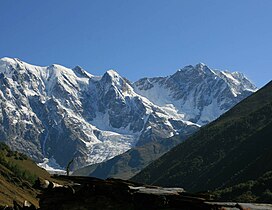Shkhara
| Shkhara | |
|---|---|
 | |
| Highest point | |
| Elevation | 5,203 m (17,070 ft)[1][2] |
| Prominence | 1,357 m (4,452 ft) |
| Listing | |
| Coordinates | 43°00′02″N43°06′44″E/ 43.00056°N 43.11222°E |
| Geography | |
| Location | Svanetiregion,GeorgiaShkhara |
| Country | Georgia |
| Parent range | Main Caucasian Range GreaterCaucasus Mountains |
| Climbing | |
| First ascent | 1888 by U. Almer, J. Cockin and C. Roth[3] |
| Easiest route | Northeast Ridge: snow/ice climb (Russian grade 4b)[4][3] |
Shkhara(Georgian:შხარა) is the highest point in the country ofGeorgia.[5]It is located near the Russian-Georgian border, in Russia'sKabardino-Balkariaregion on the northern side, and theSvanetiregion of Georgia in the south. Shkhara lies 88 kilometres (55 mi) north of the city ofKutaisi,Georgia's second-largest city, and closer to the townlet ofMestiainSvaneti.The summit lies in the central part of theGreater Caucasus Mountain Range,to the south-east ofMount Elbrus,Europe's highest mountain. Shkhara is the third-highest peak in the Caucasus, just behindDykh-Tau.[6]
Morphology
[edit]Shkhara is the high point and the eastern anchor of amassifknown as theBezengi Wall,a 11–12-kilometre-long (6.8–7.5 mi) ridge. It is a large, steep peak in a heavily glaciated region, and presents serious challenges to mountaineers. Its north face (on theRussianside) is 1,500 metres (4,900 ft) high and contains several classic difficult routes. The significant sub-summit Shkhara West, at 5,068 m (16,627 ft), is a climbing objective in its own right, and a traverse of the entire Bezingi Wall is considered "Europe's longest, most arduous, and most committing expedition".[3]
History
[edit]The peak was first climbed in 1888 via the North East Ridge route, by theBritish/Swissteam of English climberJohn Garford Cockinand Swiss guidesUlrich AlmerandChristian Roth.[7]This route is still one of the easier and more popular routes on the mountain. The first complete traverse of the Bezingi Wall was in 1931, by theAustriansK. Poppinger, K. Moldan, and S. Schintlmeister.[citation needed]
See also
[edit]References
[edit]- ^Bolashvili, Nana; Neidze, Vazha, eds. (2022).The Physical Geography of Georgia.Springer. p. 25.ISBN978-3-030-90752-5.
- ^Tielidze, Levan, ed. (2019).Geomorphology of Georgia.Springer. p. 121.ISBN978-3-319-77763-4.
- ^abcAudrey Salkeld, ed. (1998).World Mountaineering.Bulfinch Press. p. 70.ISBN0-8212-2502-2.
- ^Shkhara on Summitpost
- ^"Shkhara - Peakbagger.com".www.peakbagger.com.Retrieved2019-04-13.
- ^Shkhara. Weather Forecast, Georgiamountain-forecast.com
- ^J. G. Cockin, «Shkara, Janga, and Ushba»,The Alpine Journal,vol. XVI, n° 122, novembre 1893, pp. 477-494 - reproduced inDouglas W. Freshfield,The exploration of Caucasus,E. Arnold, 1896, Volume II, pp. 38-58



